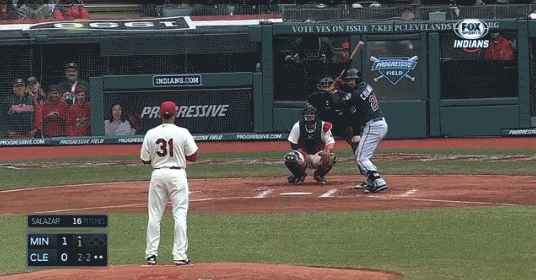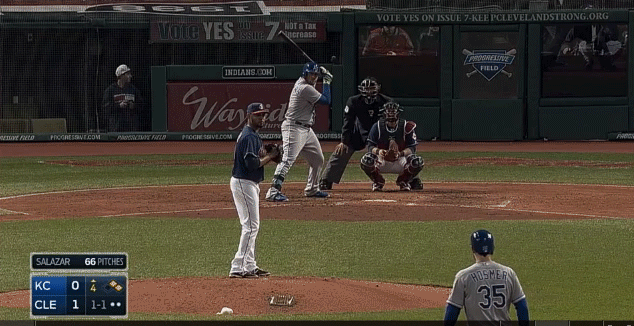Danny Salazar, Not According to Plan
Last season, Danny Salazar was among a wave of hard-throwing young pitchers that made electrifying debuts down the stretch, falling upon the national eye during the postseason.
Salazar threw 52 regular season innings over 10 starts in 2013, posting a 3.12 ERA and 3.16 FIP while striking out more than 11 batters per nine innings. His 30.8 K% was second of all starting pitchers who threw at least 50 innings, putting him behind only Yu Darvish and right ahead of Max Scherzer. His 2.75 xFIP was third in that same pool of pitchers, trailing only Matt Harvey and Felix Hernandez. His 14.6% swinging-strike percentage was tops in baseball, beating Francisco Liriano’s second-place rate by more than a full percentage point.
For 1/3 of the 2013 MLB season, 23-year-old Danny Salazar was among the most dominant starting pitchers in baseball. But with that kind of performance comes high expectations, and thus far, unlike young peers Sonny Gray, Michael Wacha and Alex Wood, Salazar is not living up to expectations.
Through his first four starts, Salazar sports a 7.85 ERA and a 5.70 FIP. Strikeouts are down, walks are up, and he has allowed five home runs in 18 innings.
Despite how good Salazar was in 2013, those who follow him and/or the Indians will likely remember his season by two big swings from two big men in two big games.
To wit:
Miguel Cabrera hit that on the first pitch with two outs in the eighth inning of a late season game between two divisional rivals battling for first place. It gave the Tigers a one-run lead, they went on to win and it was a key momentum shift in the American League Central race. Salazar had been dynamite that evening, striking out 10 Tigers and fanning Cabrera in his first three trips to the plate, until the best hitter in the MLB ultimately came out on top. It was a “welcome to the big leagues” moment right out of a screenplay.
Here, Delmon Young got a first pitch fastball in the third inning of an AL Wild Card play-in game and hit a no-doubter as no-doubty as any no-doubter could be. The Rays went on to win and Cleveland’s first playoff appearance in six years was gone as quickly as it came.
These two blemishes on an otherwise stellar 2013 campaign foreshadowed what Danny Salazar would struggle with early in the 2014 season.
Both these pitches were left up in the zone and Salazar paid for them. Elevated pitches are nothing out of the ordinary for Salazar. He works up in the zone often, as pitchers who can throw 100 miles per hour tend to and should do.

It contributed to some of his success last year, but it’s also contributing to his failures this year. There were two red flags in Salazar’s 2013 numbers that were concerning to begin with and are now trending in the wrong direction. The first was his inability to generate ground balls. Salazar’s ground ball rate of 34.4% would have ranked in the bottom 10 of qualified starting pitchers last season. To make matters worse, 13.7% of Salazar’s fly balls left the yard, also a bottom-10 figure. It’s tough for any pitcher to sustain success without generating ground balls or while giving up a lot of home runs. Combine the two and you’ve got a problem on your hands.
Danny Salazar knows he needs to get more ground balls. In spring training he was working on “being a little more consistent with keeping the ball down.”
That’s not exactly happening. Salazar’s ground ball rate has plummeted to 25.9%. His HR/FB is up to 18.5%. Let’s take a look at the home runs that Salazar has conceded through his first four starts of 2014.
No. 1 – Chris Colabello

86 mph slider, elevated and left over the heart of the plate.
No. 2 – Alexei Ramirez

85 mph split finger changeup that was thrown right down the middle of the plate and stayed up for too long.
No. 3 – Jose Abreu

88 mph slider, left way up in the zone and over the heart of the plate. Can’t hang a slider much worse than that and Salazar knew it immediately.
No. 4 – Ian Kinsler
This one was a fastball. Flat and elevated. It was a 3-1 count and Kinsler knew the fastball was coming. 18 times in Danny Salazar’s young career has he found himself in a 3-1 count. All 18 times he has come back with a fastball. Kinsler knew Salazar couldn’t trust his offspeed stuff, sat on the fastball and put it in the left field seats to give the Tigers a 4-3 lead.
No. 5 – Mike Moustakas

84 mph slider elevated and left over the middle to an opposite-handed hitter. Might be even worse than the pitch to Abreu.
The slider clearly is an issue. Every time a batter has got a hit off Danny Salazar’s slider this season, that hit has been a home run. Consider this simple scatter chart of Salazar’s sliders in 2014:

What you’ve got down at the bottom there is six sliders in the dirt, five of which went for balls. Of the remaining 20 sliders that weren’t in the dirt, only six were below the waist, where you want a good slider to wind up. That’s a lot of elevated, hittable sliders, as evidenced by the three in the middle there that went out of the park.
Then there’s the split change. This is Salazar’s out pitch. Its elite 22% whiff rate last year was the best in his arsenal and a result it accounted for nearly half of his strikeouts. However, it also needs to serve as his ground ball pitch, seeing his slider doesn’t generate any grounders, his fastball lives up in the zone and he doesn’t really throw a sinker or two seamer. Last season the split change had a 10.7% ground ball rate. This year, he has gotten only two ground balls with it and his rate is down to 2.99%. This could have something to do with the fact that, after watching video of his last start, Salazar believes he may be tipping the pitch. “With my changeup sometimes, I open up my glove too much,” Salazar said.
So, the split change isn’t getting any ground balls and he may be letting the batter know it’s coming. The sliders are all up in the zone and every time someone hits one it goes out of the park. Factor into the equation that his fastball velocity has dropped two miles per hour and its whiff rate has gone from 14% to 9% and its not hard to see why Salazar has struggled early on. All three of his pitches have had something wrong with them.
The Indians shouldn’t be so quick to pull the trigger on demoting him as some have suggested just yet, as this four game sample shouldn’t make us forget the elite production Salazar proved he was capable of last season. But that’s not to ignore that four games and 18 innings already make up nearly 30% of his major league body of work and his career ERA and FIP have already jumped to 4.35 and 3.83. With Trevor Bauer seemingly finding new life in Triple-A, if Danny Salazar doesn’t begin to correct these trends over his next several starts, you’ll have to wonder how long the Indians can let him work on trying to fix all three of his pitches.
August used to cover the Indians for MLB and ohio.com, but now he's here and thinks writing these in the third person is weird. So you can reach me on Twitter @AugustFG_ or e-mail at august.fagerstrom@fangraphs.com.
More’s the pity because you can plainly see just how electric Danny Salazar’s stuff is, and just how lively his best pitches are. So far this year he has walked a line between domination and disaster, or I suppose walked it drunkenly, weaving from one to the other.
By the way, credit to the Akron Beacon Journal for employing a stathead such as yourself!
I don’t understand. You cite the 18.5% HR/FB ratio… as a reason to worry? It’s a pretty widely accepted tenet that HR/FB ratio is a stat that stabilizes around league average for fly ball pitchers – and you can argue that it won’t in Salazar’s case. You can do that; that’s allowed. But to do that, you’d need to prove that Salazar is unlike other Fly Ball pitchers in some way.
I was watching yesterday’s game with Bruce Chen on the mound – and Chen leaves ’em up there with the best of them. Not a single home run. Pitchers leave pitches up all the time, but they don’t get punished as hard as Salazar. You need to prove that your story is more plausible than the Null Hypothesis – that Salazar’s HR/FB ratio isn’t just noise. Leaving pitches up leads to Fly Balls. The only reason we don’t harp on all the other pitchers missing their targets is because they don’t have an 18%HR/FB ratio. I suspect if one were to look at other FB pitchers, one would find they have a massive number of pitches you could make GIFs of and say ‘see, he should be getting clobbered.’
I understand there’s a need to try to explain it, but I’m not sure if there even is anything that needs explaining. I don’t think you’ve proven adequately that there is.
Also, this comes off as more confrontational than I intended. Please accept my apologies, and know that I appreciate that you put in effort.
The point is that last season Salazar got by despite not generating any ground balls. In the offseason, he made it a point that he needed to generate more ground balls. Now, he is getting even less ground balls.
The 25% ground ball rate was more of the thing I was citing as a reason to worry. The home run ratio is just the icing on the cake that is leading to him getting pounded.
Yes, obviously his slider isn’t going to continue running a 100% HR-to-hit ratio and his HR/FB% is likely to come down. The point is that for a guy whose focus in the offseason was to keep the ball down and get more groundballs, he’s not doing a very good job.
First point, I again apologize for being a confrontational dick.
Second, it makes sense to include information about his periphs – HR/FB, etc. – to contextualize, but I worry that the way they’re presented muddles your message more than clarifies it. If your point is that he’s not keeping the ball down – that’s a good point. But it’s overshadowed by a general confusion as to the actual thrust of your argument.
Finally, the point that he needs to induce grounders, and that inducing grounders is good, is certainly lucid and correct – yet does his stuff, the actual trajectories of the pitches – does his stuff really lend itself at all to GBs? His 4-seam’s a riser, so the most probable outcome for that pitch is that it induces a whiff, a late foul, a fly ball of varying contact quality, or a very hard grounder (which is probably what would occur if he did pound the bottom of the zone with his fourseam, I’d guess, based on a thoroughly irresponsible mental image of physics). His fastball doesn’t really lend itself to GB contact. This doesn’t necessarily negate your point, but what are your thoughts? Would this suggest that in 1-0 or 0-1 counts he go primarily with his offspeed/breaking stuff? Actual question.